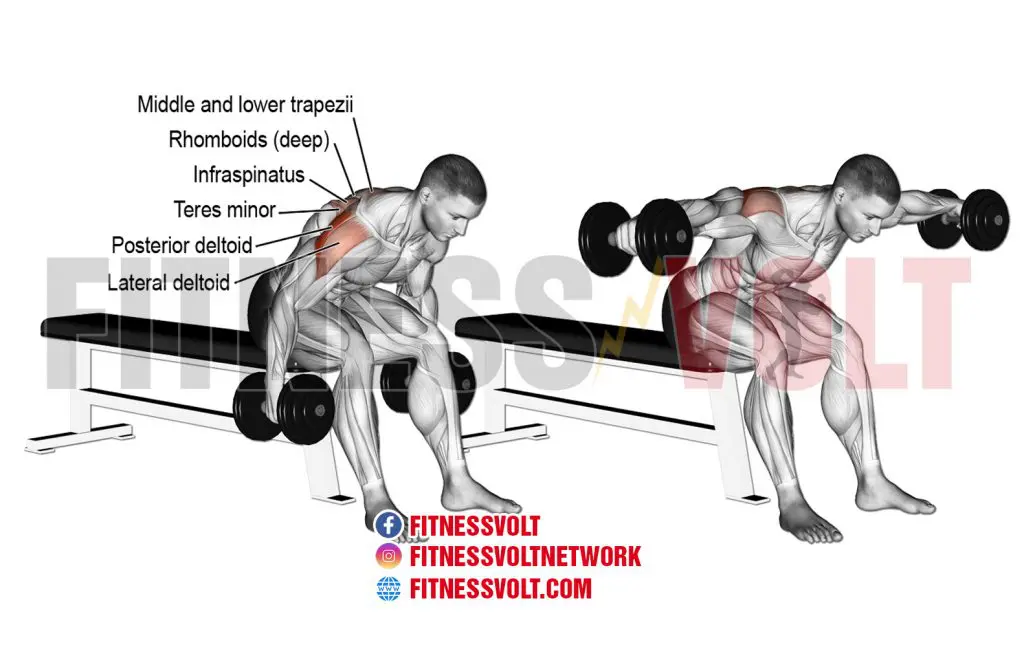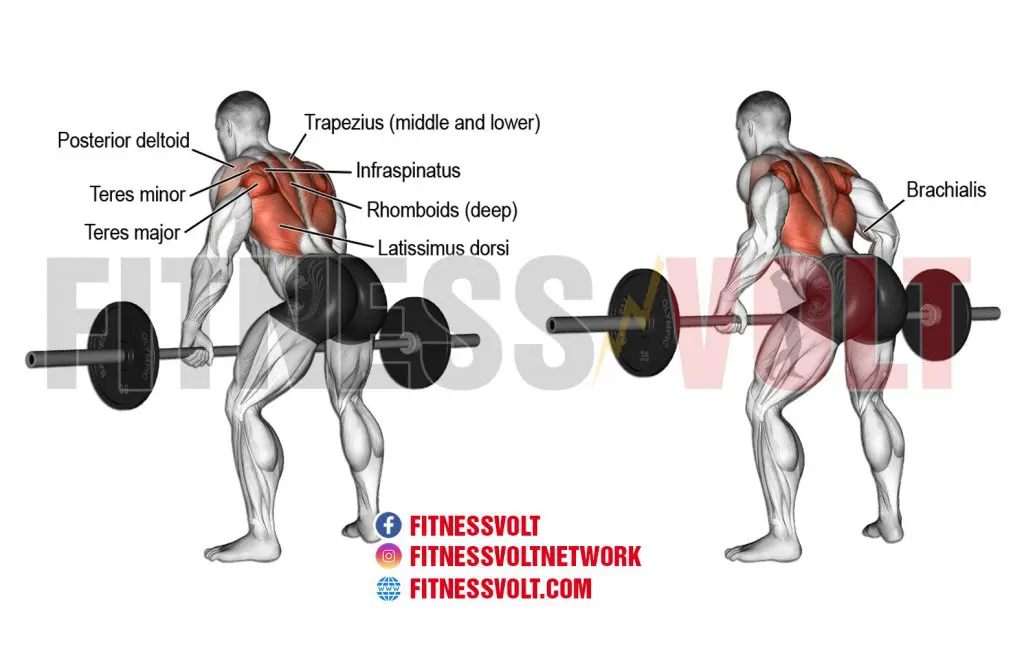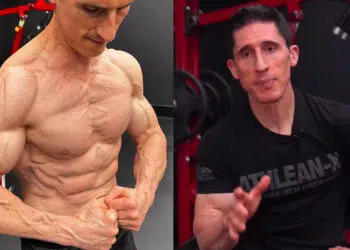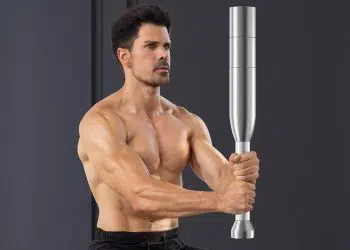The rear deltoids are undoubtedly the most neglected of the three delt heads.
But why?
Since we can’t see them and there is not always enough focus in this muscle group, they’re often “forgotten.” But sometimes, people think rear delts are too insignificant to train.
And another reason is that many assume the rear delts get worked plenty during back training and overhead shoulder presses. Although back and shoulder exercises work the rear delt, they mainly target the anterior and lateral shoulder heads.
Research shows that focusing on rear deltoid-specific exercises is more effective at building bigger and stronger posterior delts than relying only on compound movements like shoulder presses and push-ups. (1)
So if you want a fully developed and functional muscle, you must perform exercises that target them from different angles. So, we’ve compiled some effective rear delt exercises, and now there’s no excuse for you to skip them on shoulder day!
Level Up Your Fitness: Join our 💪 strong community in Fitness Volt Newsletter. Get daily inspiration, expert-backed workouts, nutrition tips, the latest in strength sports, and the support you need to reach your goals. Subscribe for free!
What are Rear Delts?
The rear deltoids, also known as the posterior deltoids, are one of the three muscles that form the deltoids. The anterior and lateral delts are the other two delt heads. As the name suggests, the rear delts are present at the back of the deltoid muscle.
Rear Deltoid Function
The rear or posterior deltoids are involved in transverse extension (internal rotation of shoulders) and transverse abduction (external rotation of shoulders). The rear delts are the main shoulder hyper-extensor, and the muscle originates from the scapula and inserts into the humerus.

Exercises that require external rotation (hyperextension) of the shoulders are the most beneficial for stimulating the rear deltoids.
Benefits of Training Your Rear Deltoids
Adding rear deltoid exercises to your training regimen entails the following advantages:
Enhances Aesthetics
Folks that lift weights to build an aesthetically appealing physique must improve their muscular symmetry, balance, and proportions. Training your rear delts will give your shoulders the coveted 3D look, making them look bigger, rounder, and fuller.
Builds Shoulder Strength
Rear delts play a significant role in your pushing strength. You must add posterior deltoid exercises to your training regime if you want to build a bigger bench. Plus, since the rear delts are on your back, they play a significant role in pulling movements, such as the bent-over row. Although rear delts are a small muscle group, you cannot neglect training them.
Improves Posture
Many people spend most of their day on their computers or hunched over their phones, which can lead to a rounded back. Performing rear delt exercises can help undo some of this damage by strengthening your posterior chain.
Boosts Functionality and Reduces Your Risk of Injury
Since rear delts are engaged in pushing and pulling movements, strengthening your posterior delts can improve your overall functioning, boosting your performance in workouts and daily tasks. These can also help fix muscle and strength imbalances, reducing your risk of injury.
The Best Rear Deltoid Exercises
“You have to target the shoulder with more than one exercise, and you have to be aware which area of the deltoid each exercise is targeting,” said Samantha Sweeney, M.S., and lead researcher for the Clinical Exercise Physiology program at the University of Wisconsin—LaCrosse.
Here are the 23 best exercises rear delt exercises to take your shoulder gains to the next level:
1. Dumbbell Seated Rear Lateral Raise
A study by ACE showed the seated rear delt raise to be among the most effective exercises based on EMG (electromyography) testing. (2)
John P. Porcari, Ph.D., head of the Clinical Exercise Physiology program at the University of Wisconsin—LaCrosse, favors the seated lateral raise compared to other exercises. “I like the seated rear lateral raise just because it’s easier,” said Porcari.
In This Exercise:
- Target Muscle Group: Rear Deltoids
- Secondary Muscles: NA
- Type: Strength
- Mechanics: Isolation
- Equipment: Dumbbell
- Difficulty: Beginner
- Best Rep Range:
- Hypertrophy: 8-12
- Strength: 2-5
How to do the exercise:
- Sit on the edge of a bench while holding a dumbbell in each hand.
- Keep your back straight and bend over slightly.
- With an overhand grip and elbows slightly bent, raise both dumbbells up until you can feel your rear delts working.
- Slowly lower the dumbbells back to the starting position.
- Repeat for recommended reps.
Pro Tip: Use a lighter weight, bend your torso even more forward, and slow down your rep tempo if you have difficulty establishing a mind-muscle connection.
2. 45-Degree Dumbbell Incline Row
The previously mentioned ACE study concluded that the 45-degree incline is on par with the seated rear delt raise for activating the posterior deltoids.
This variation will allow you to use more weight, which is excellent for overloading the muscles. And muscle overload = growth!
In This Exercise:
- Target Muscle Group: Rear Deltoids
- Secondary Muscles: Biceps and Lats
- Type: Strength
- Mechanics: Compound
- Equipment: Dumbbell
- Difficulty: Beginner
- Best Rep Range:
- Hypertrophy: 8-12
- Strength: 1-5
How to do the exercise:
- Adjust the bench to a 45-degree angle.
- Lie chest down on the bench with the balls of your feet on the floor and let your arms hang down.
- Hold the dumbbells with a neutral grip and keep your back straight.
- Drive your elbows toward the ceiling and contract your rear deltoids at the top of the motion.
- Slowly return to the starting position.
Pro Tip: Your elbows should be in a straight line throughout the range of motion. Caving in your elbows will remove the tension from your rear delts and put it on your lats.
3. Standing Cable Reverse Fly
Cables are a great tool for keeping tension on the target muscle group, and they allow you to move through a more natural range of movement than machines. Standing during an exercise is also beneficial because your core stabilizer muscles are engaged.
In This Exercise:
- Target Muscle Group: Rear Deltoids
- Secondary Muscles: NA
- Type: Strength
- Mechanics: Isolation
- Equipment: Cables
- Difficulty: Beginner
- Best Rep Range:
- Hypertrophy: 8-12
- Strength: 1-5
How to do the exercise:
- Attach a D-handle bar to each cable pulley at shoulder level.
- Alternatively, you can grip the cable itself.
- Grab the left handle with your right hand and the right handle with your left hand but remain between both pulleys.
- Take a step back. The weight should be engaged at the bottom of the range of motion.
- Assume a staggered stance for better balance.
- With elbows bent, pull the ends of the cables away from each other, so they cross and perform a reverse fly. Keep your arms at shoulder level during the exercise.
- Bring both cables back until your hands meet in the center of your body.
Pro Tip: Maintain an upright torso throughout the exercise. Bending forward or backward will remove tension from the rear delts and put it on secondary muscles.
4. Reverse Pec Deck Fly
This exercise is performed on the pec deck machine. You can generally use heavier weights with these types of exercises, which is very beneficial for muscle hypertrophy.
In This Exercise:
- Target Muscle Group: Rear Deltoids
- Secondary Muscles: NA
- Type: Strength
- Mechanics: Isolation
- Equipment: Pec Deck Machine
- Difficulty: Beginner
- Best Rep Range:
- Hypertrophy: 8-12
- Strength: 1-5
How to do the exercise:
- Set the levers as close to the machine as possible so you have to reach straight in front of you to grip the handles.
- Sit facing the weight stack and grab both handles with elbows bent.
- Pull the levers back and engage your rear delts while keeping your back straight.
- Return your arms back to in front of you but avoid touching the weight to the rest of the stack.
Pro Tip: Keep your forehead and chest glued to the pad throughout the exercise. Focus on driving through your elbows for optimal rear delt stimulation.
Related: Best Pec Deck Alternatives
5. Cable Rope Face Pull
Face pulls are a great movement for working the upper posterior chain muscles. It works the traps, rhomboids, and rear delts. So, many people love this exercise because it’s also a great accessory movement that helps improve your bigger lifts.
In This Exercise:
- Target Muscle Group: Rear Deltoids
- Secondary Muscles: Traps and Rhomboids
- Type: Strength
- Mechanics: Compound
- Equipment: Cables
- Difficulty: Beginner
- Best Rep Range:
- Hypertrophy: 8-12
- Strength: 1-5
How to do the exercise:
- Set the rope attachment to chest level on the cable pulley.
- Assume a staggered stance for balance.
- Grip the rope attachment with an overhand grip. Lower your elbows so that they’re halfway between parallel to the floor and your torso.
- Pull the rope toward your face and squeeze your rear delts.
Pro Tip: Pull at a slight downward angle for optimal rear delt engagement. You can contract your posterior delts better using this technique at the static contraction point at the bottom.
6. Dumbbell Bent-Over Reverse Fly
This reverse fly variation requires you to stand in a bent-over position. It’s important to ensure you’re not using momentum for this exercise, as it can alleviate tension from your posterior delts. I recommend using a weight you can handle comfortably without compromising good form.
In This Exercise:
- Target Muscle Group: Rear Deltoids
- Secondary Muscles: NA
- Type: Strength
- Mechanics: Isolation
- Equipment: Dumbbell
- Difficulty: Beginner
- Best Rep Range:
- Hypertrophy: 8-12
- Strength: 1-5
How to do the exercise:
- While holding a dumbbell in each hand, bend your torso over while keeping your back straight and bend your knees slightly.
- Bend your elbows and raise both dumbbells up and outward until your arms are parallel to the floor while engaging your rear delts. Use an overhand grip and keep the dumbbells in a neutral position.
- Bring both dumbbells back down until they nearly touch.
Pro Tip: Use a weight that will allow you to complete 8-12 reps comfortably. Going too heavy can push you toward using momentum, which can remove tension from your rear delts.
7. Wide-Grip Inverted Row (Smith Machine)
You’ll need a little upper body strength for this one, but not as much as a bodyweight pull-up. This exercise is different, and it’s also called the Australian pull-up. Your rhomboids (upper back muscles) will get worked along with your traps and biceps.
You’ll just need a Smith machine to do this exercise. You can also perform this exercise on a barbell racked at a waist-height in a squat rack.
In This Exercise:
- Target Muscle Group: Rear Deltoids
- Secondary Muscles: Rhomboids, Lats, Traps, and Biceps
- Type: Strength
- Mechanics: Compound
- Equipment: Smith Machine or Racked Barbell
- Difficulty: Beginner
- Best Rep Range: 8-12
How to do the exercise:
- Set up the Smith machine bar so that it’s high enough for you to hang from beneath without touching your back to the floor.
- Get underneath the bar and grip it with hands wider than shoulder-width. Your feet should be straight out with your heels touching the floor.
- Pull yourself up to the bar.
- Slowly lower your body back down until your arms are extended.
Pro Tip: The wider your grip, the better your rear delt engagement in this exercise. Avoid using a narrow grip, as it will put more focus on your lats.
8. Single-Arm Cable Reverse Fly
Unilateral training is beneficial for fixing muscle and strength imbalances, improving core stabilization, and preventing injuries. (3)
In This Exercise:
- Target Muscle Group: Rear Deltoids
- Secondary Muscles: NA
- Type: Strength
- Mechanics: Isolation
- Equipment: Cable
- Difficulty: Beginner
- Best Rep Range:
- Hypertrophy: 8-12
- Strength: 1-5
How to do the exercise:
- Set the cable pulley to shoulder level on one side of the machine and attach a D-handle bar.
- Stand so your left side is facing the cable pulley, and grab the handle with your right hand.
- Take a step to the right, bend your elbow, and do a reverse fly.
- Complete the desired number of reps on your right side before switching sides.
Pro Tip: Many lifters make the mistake of moving their working shoulder forward and backward during the exercise, which results in lateral deltoid engagement. Hold your shoulder steady for optimal rear delt stimulation.
9. Barbell Bent-Over Rear Delt Row
The barbell row is arguably the best overall back exercise as it works every upper posterior chain muscle, including the rear delts.
In This Exercise:
- Target Muscle Group: Lats
- Secondary Muscles: Rear Deltoids and Rhomboids
- Type: Strength
- Mechanics: Compound
- Equipment: Barbell
- Difficulty: Beginner
- Best Rep Range:
- Hypertrophy: 8-12
- Strength: 1-5
How to do the exercise:
- Use an overhand grip with hands slightly wider than shoulder-width apart.
- Bend your torso over while maintaining a straight back and keep your knees slightly bent.
- Use your rear delts to pull the barbell up toward your sternum or lower ribcage area.
- Pause and contract your lats at the top of the movement for two seconds.
- Lower the barbell so your arms are almost fully extended.
Pro Tip: Hold your torso as low to the floor as possible. This will require you to use relatively lighter weights than your conventional bent-over row weights.
10. Resistance Band Face Pull
Bands are an excellent training tool as they place constant tension on the target muscle. This face pull variation is great for folks who train at home or want to add variety to their training regimen.
In This Exercise:
- Target Muscle Group: Rear Deltoids
- Secondary Muscles: Rhomboids
- Type: Strength
- Mechanics: Compound
- Equipment: Resistance Band
- Difficulty: Beginner
- Best Rep Range: 8-12
How to do the exercise:
- Wrap the band around a bar or pole at your upper chest level.
- Grip the band with both hands so your thumbs are pointing toward your face.
- Stand with your feet hip-width apart.
- Pull the band toward the center of your face.
- Return to the start position.
- Repeat for reps.
Pro Tip: Focus on pulling the bands using your rear delts. Also, avoid extending your elbows at the bottom to keep constant tension on the target muscle.
11. Resistance Band Pull-Apart
The resistance band pull-apart is an incredibly versatile exercise. You could use it as a warm-up exercise before every upper body workout, as a main exercise to train your rear delts, as a superset, or as a finisher to exhaust the back of your shoulders.
Since this exercise only requires a resistance band, folks who train at home can also use it to bring up their rear delts, which is a stubborn muscle group for most people. Use a high number of reps on this exercise to exhaust your posterior delts.
Level Up Your Fitness: Join our 💪 strong community in Fitness Volt Newsletter. Get daily inspiration, expert-backed workouts, nutrition tips, the latest in strength sports, and the support you need to reach your goals. Subscribe for free!
In This Exercise:
- Target Muscle Group: Rear Deltoids
- Secondary Muscles: NA
- Type: Strength
- Mechanics: Isolation
- Equipment: Resistance Band
- Difficulty: Beginner
- Best Rep Range: 8-12
How to do the exercise:
- Stand upright with a hip-width stance while holding a resistance band in both hands using an overhand grip.
- Extend your arms in front of you so they are parallel to the floor.
- Keeping your elbows locked, extend your arms to your sides until they are in line with each other.
- Pause and contract your rear delts.
- Slowly return to the start position.
- Repeat for recommended reps.
Pro Tip: As you gain more experience, switch to the heaviest resistance band you can use without compromising your form. Ensure that you are following a consistent rep tempo.
12. Single-Arm Bent-Over Row
Your form on the single-arm bent-over row will change slightly to focus on your rear deltoids. Instead of pulling with your elbow tucked to your side, you must flare it out to engage the posterior delt. Keeping your arm close to your side will transfer the focus to your lats.
In This Exercise:
- Target Muscle Group: Lats
- Secondary Muscles: Rear Deltoids
- Type: Strength
- Mechanics: Compound
- Equipment: Dumbbell
- Difficulty: Beginner
- Best Rep Range:
- Hypertrophy: 8-12
- Strength: 1-5
How to do the exercise:
- Assume a hip-width stance while holding a dumbbell in your right hand.
- Bend forward until your torso is almost parallel to the floor.
- Place your left hand on your left thigh for support. Alternatively, place it on an elevated surface like a dumbbell rack.
- While bending at your elbow, lift your elbow to your side so that your arm is almost perpendicular to your torso.
- Return to the starting position.
- Repeat for recommended reps before switching sides.
Pro Tip: Maintain the natural arch in your back while performing this exercise. Rounding your back will turn the focus to your lats and rhomboids.
13. Pull-Up
Most exercisers overlook the pull-up while training to bring up their posterior deltoids. Your posterior delts engage during the eccentric and concentric pull-up motion. You must, however, follow a controlled rep tempo to work your rear delts.
In This Exercise:
- Target Muscle Group: Lats
- Secondary Muscles: Shoulders, Arms, Chest, and Abs
- Type: Strength
- Mechanics: Compound
- Equipment: Bodyweight
- Difficulty: Beginner
- Best Rep Range:
- Hypertrophy: 8-12
- Strength: 1-5
How to do the exercise:
- Jump and grab a pull-up bar at shoulder-width using an overhand grip.
- Lift your body by actively pushing your elbows toward the floor and using your lats and rear delts to pull yourself toward the bar.
- Your chin should be over the bar at the top.
- Slowly return to the start position.
- Rinse and repeat.
Pro Tip: People that don’t have the strength to perform bodyweight pull-ups can also use the assisted pull-up machine. Experienced lifters can also use the assisted machine to focus on their rear delts.
14. Y Raise
The Y raise is an underutilized but highly effective exercise to work the shoulders, especially the rear delts. This exercise’s unique setup helps you prioritize the posterior deltoids. Beginners should master this exercise’s bodyweight variation before using dumbbells.
In This Exercise:
- Target Muscle Group: Shoulders
- Secondary Muscles: NA
- Type: Strength
- Mechanics: Isolation
- Equipment: Dumbbells
- Difficulty: Beginner
- Best Rep Range:
- Hypertrophy: 8-12
- Strength: 1-5
How to do the exercise:
- Set an incline bench at a 45-degree angle with the floor.
- Grab a dumbbell in each hand and place your chest against the inclined pad. Keeping your feet planted on the floor will help you maintain your balance.
- Keeping your back arched and shoulder blades pulled back, raise your arms toward the ceiling without bending your elbows.
- Your arms and torso should resemble a “Y” at the top of the movement.
- Pause at the top and contract your rear delts.
- Return to the start position.
- Repeat for reps.
Pro Tip: More experienced lifters can also perform this exercise on the cable pulley machine. Cables help maintain constant tension on your target muscle throughout the range of motion.
15. T Raise
The T raise is similar to the Y raise. However, instead of raising your arms overhead, you will raise them to your sides in this exercise. Some people experience better rear delt stimulation in this exercise than the Y raise. Nonetheless, you must add both exercises to your exercise arsenal for overall shoulder development.
In This Exercise:
- Target Muscle Group: Shoulders
- Secondary Muscles: NA
- Type: Strength
- Mechanics: Isolation
- Equipment: Dumbbells
- Difficulty: Beginner
- Best Rep Range:
- Hypertrophy: 8-12
- Strength: 1-5
How to do the exercise:
- Set an incline bench at a 45-degree angle.
- Place your chest on the incline bench while holding a dumbbell in each hand.
- Maintaining the natural arch in your spine, lift your arms to your side without bending your elbows.
- Slowly return to the starting position.
- Repeat for reps.
Pro Tip: As you get better at the Y raise and T raise, you can perform a complex of these exercises to engage your rear delts better. Perform a rep of Y raise and follow it up with a T raise; alternate between these exercises for the desired reps. You can take it a step further by doing the YTI raises.
16. Lying Rear Delt Circles
The lying rear delt circle is an incredibly effective exercise as it works your shoulders through their full range of motion. Drill the bodyweight version of this exercise before adding weights.
In This Exercise:
- Target Muscle Group: Shoulders
- Secondary Muscles: NA
- Type: Strength
- Mechanics: Isolation
- Equipment: Dumbbells
- Difficulty: Beginner
- Best Rep Range: 8-12
How to do the exercise:
- Lie prone on the floor.
- Extend your hands overhead. Your thumbs and index fingers should be touching at the start position.
- Pull back your shoulder blades and arch your back. Feel free to lift your chin off the floor. It will help you get some leverage.
- Without bending your elbows, bring your arms to your sides so that your hands touch the sides of your thighs.
- Slowly return to the starting position.
Pro Tip: Performing this exercise on an elevated platform, such as a flat bench, adds to the difficulty, as you’ll need greater core and stabilizer engagement.
17. Side-Lying Rear Delt Raise
This advanced exercise requires a decent mind-muscle connection for optimal results. Start with a lighter dumbbell until you can feel your rear delts working.
In This Exercise:
- Target Muscle Group: Rear Deltoids
- Secondary Muscles: NA
- Type: Strength
- Mechanics: Isolation
- Equipment: Dumbbell
- Difficulty: Intermediate
- Best Rep Range: 8-12
How to do the exercise:
- Lie on your right side on a flat bench. Your left shoulder should hang off the bench, and your hips and legs should be stacked.
- Place your left hand on the floor for support.
- While holding a dumbbell in your right hand, raise it toward the ceiling so it is perpendicular to your torso.
- Maintaining a slight bend in your elbow, lower your right hand in front of your body until it is parallel to the floor.
- Return to the start position.
- Repeat for reps before switching sides.
Pro Tip: Perform this exercise on the floor if you have difficulty maintaining stability on the flat bench. On the other hand, advanced lifters can perform this movement on an incline bench.
18. Dumbbell Rear Delt Raise with Head Support
This bent-over rear delt raise variation involves keeping your head on the edge of an incline bench. This setup eliminates the chances of using momentum to lift the weight.
In This Exercise:
- Target Muscle Group: Rear Deltoids
- Secondary Muscles: NA
- Type: Strength
- Mechanics: Isolation
- Equipment: Dumbbells and Incline Bench
- Difficulty: Beginner
- Best Rep Range: 8-12
How to do the exercise:
- Set an incline bench at a 30-degree angle with the floor.
- Holding a dumbbell in each hand, stand facing the inclined end of the bench.
- Bend over and place your forehead on the edge of the bench.
- Raise the dumbbells to your sides while maintaining a slight bend in your elbows.
- Use a controlled eccentric motion to return to the start position.
Pro Tip: You must use lighter weights on this exercise than the conventional bent-over rear delt raises.
19. Single-Arm Supported Bent-Over Rear Delt Raise
The single-arm supported bent-over rear delt raise is the opposite of the head-supported variation. Holding onto a sturdy subject while performing this movement lets you go as heavy as possible.
In This Exercise:
- Target Muscle Group: Rear Deltoids
- Secondary Muscles: NA
- Type: Strength
- Mechanics: Isolation
- Equipment: Dumbbell
- Difficulty: Beginner
- Best Rep Range:
- Hypertrophy: 8-12
- Strength: 1-5
How to do the exercise:
- Stand facing a sturdy object, such as an incline bench or dumbbell rack.
- Bend over and place your right hand on the dumbbell rack. Grab a dumbbell in your left hand.
- Raise the dumbbell to your side while maintaining a slight bend in your elbow.
- Pause and contract your rear delt at the top.
- Switch sides after completing the desired reps.
Pro Tip: Holding onto an object allows you to lift heavy. However, you must avoid swinging your back up and down to generate momentum.
20. Incline Prone Dumbbell Shrug
The dumbbell shrug on an incline bench can help isolate the rear delts. You must, however, pull your shoulders toward the ceiling instead of raising your shoulders to your ears for optimal posterior deltoid engagement.
In This Exercise:
- Target Muscle Group: Shoulders
- Secondary Muscles: Trapezius Muscle
- Type: Strength
- Mechanics: Isolation
- Equipment: Dumbbells
- Difficulty: Beginner
- Best Rep Range:
- Hypertrophy: 8-12
- Strength: 1-5
How to do the exercise:
- Set an incline bench at a 45-degree angle.
- Lie prone on the bench while holding a dumbbell in each hand.
- Pull your shoulders toward the ceiling and pinch your shoulder blades together.
- Pause and contract your rear delts at the top.
- Slowly return to the starting position.
- Repeat for reps.
Pro Tip: Follow a full range of motion for optimal rear delt stimulation. Chasing big weights too soon can limit your range of motion.
21. Bodyweight Prone Reverse Fly
The prone reverse fly is a bodyweight exercise that focuses on rear delt contraction. This exercise can also improve your thoracic mobility, which can improve your overall functionality.
In This Exercise:
- Target Muscle Group: Rear Deltoids
- Secondary Muscles: NA
- Type: Strength
- Mechanics: Isolation
- Equipment: Bodyweight
- Difficulty: Beginner
- Best Rep Range: 15-20
How to do the exercise:
- Lie prone on the floor.
- Extend your arms at your sides so they are perpendicular to your torso.
- While maintaining the natural arch in your back, raise your arms toward the ceiling as high as possible.
- Pause and contract your rear delts at the top.
- Rinse and repeat.
Pro Tip: As you get better at this exercise, raise your chest off the floor during the concentric (upward) motion to achieve a greater range of motion.
22. Cable Bent-Over Reverse Fly
This exercise helps maintain constant tension on your rear delts throughout the range of motion. Use this cable bent-over rear delt fly as a finisher to end your training session with a nasty rear delt pump.
In This Exercise:
- Target Muscle Group: Rear Deltoids
- Secondary Muscles: NA
- Type: Strength
- Mechanics: Isolation
- Equipment: Cables
- Difficulty: Beginner
- Best Rep Range:
- Hypertrophy: 8-12
- Strength: 1-5
How to do the exercise:
- Adjust the cable pulleys at the lowest setting and set-up D-handle attachments on both ends.
- Grab the right handle in your left hand and the left handle in your right handle.
- Position yourself in the center of the cable pulley machine and assume a hip-width stance.
- Bend over so your torso is almost parallel to the floor.
- While maintaining a slight bend in your elbows, lift your arms to your sides.
- Pause and contract your rear delts at the top.
Pro Tip: Alternate between an overhand and neutral grip to target your rear delts from different angles.
23. Landmine Row For Rear Delt
The landmine row is primarily an exercise for the latissimus dorsi. However, you can tweak your form to prioritize your rear delts. Check out the step-by-step instructions for more details.
In This Exercise:
- Target Muscle Group: Lats
- Secondary Muscles: Rear Delts
- Type: Strength
- Mechanics: Compound
- Equipment: Barbell
- Difficulty: Beginner
- Best Rep Range:
- Hypertrophy: 8-12
- Strength: 1-5
How to do the exercise:
- Set up a barbell in a landmine attachment.
- Stand at the free end of the barbell. Your left side should be facing the barbell.
- Get into a staggered stance and grab the bar at the edge of the sleeve.
- Arch your back and drive your elbow out to your side and toward the ceiling. Your elbow will bend during the concentric motion.
- Pause and contract your rear delts at the top.
- Repeat for recommended reps before switching sides.
Pro Tip: Avoid bringing your elbows into your side, as it will result in a greater lat engagement.
Training Tips For Rear Delts
Here are a few rear delt training tips to take your gains to the next level:
- Always warm up with a few sets before lifting heavy. Two sets of 30 and 50-60% of your one-rep max in a pyramid sequence can help warm up the muscles and prevent injury.
- Focus on establishing a mind-muscle connection. This allows for increased activation and engagement of the rear deltoids through a fuller range of movement.
- Never tip dumbbells forward or internally rotate your shoulders, as it can cause shoulder impingement issues.
- Never point your elbows outward during an exercise, as this can also lead to injury. Always make sure to tuck them in or down slightly.
- Keep progressing with the weight as long as you maintain good form. Muscles will only grow with progressive overload.
- Avoid cheating. A little momentum is fine as long as you’re still allowing the muscle to do most of the work.
Sample Rear Delt Workout
Here’s an effective rear delt workout you should try the next time you hit the gym:
| Exercise | Sets | Reps | Rest |
| Dumbbell Seated Rear Delt Raise | 3 | 10 | 60 seconds |
| Wide-Grip Inverted Row | 3 | AMRAP | 60 seconds |
| Cable Rope Face Pull | 2 | 12 | 60 seconds |
You can perform this rear delt routine at the end of your back or shoulder workout to add size, thickness, and definition to your shoulders.
FAQs
Are rear delts a part of your shoulders or back?
Rear deltoids are one of the three delt heads, making them a part of your shoulders. However, since they are located on your back, many lifters prefer training them on their back day. Programming them into your training regimen will depend on your preferences; both approaches are correct.
Individuals with lagging rear delts should train this muscle group at the beginning of their workouts, regardless of whether they train them on the shoulder or back day. Train the weak muscle groups when you are still fresh for optimal muscle fiber stimulation.
Can dumbbell rows train your rear delts?
Bent-over dumbbell rows are a compound exercise that engages multiple muscle groups, including your back, shoulders, traps, and biceps. Performing dumbbell bent-over rows can engage your rear delts. To maximize rear delt stimulation, you must avoid using momentum by swinging your back up and down.
Since the posterior deltoid is a small muscle, using momentum can limit its engagement. Folks that use momentum during the dumbbell or barbell row end up prioritizing their biceps. Furthermore, you must focus on contracting your back and rear delts at the static contraction point at the top of the range of motion for optimal posterior deltoid stimulation.
Does the pull-up train your rear delts?
Yes. Pull-ups are a compound lift that engages almost every muscle in the upper body. The rear delts power the concentric (upward) and stabilize the eccentric (downward) movement of the pull-up.
For optimal posterior delt engagement, you must use a strict form. Avoid generating momentum by swinging your legs. Using an assisted pull-up machine can also help you focus on your rear delts by allowing you to establish a mind-muscle connection during the concentric and eccentric parts of the movement.
How many rear delt exercises should I do in a workout?
Since the posterior deltoids are a small muscle group, doing two to three exercises for this muscle group in a workout is sufficient. However, ensure you train your rear delts from different angles for overall development.
For example, if the first movement in your rear delt regimen is a bent-over dumbbell rear delt fly, the next exercise should be a rear delt pec deck fly. Train the muscles using different equipment and different angles. In this example, we used a compound using free weights and an isolation exercise using cables. The multi-joint exercise will help build muscle, whereas the latter movement will help improve conditioning.
Do I need to do a dedicated rear delt workout?
Whether you need a dedicated rear delt workout will depend on your current physique and training objective. If you have lagging muscle groups, you can train your rear delts in a dedicated workout later in the day as a second workout.
Since this is a small muscle group, most people don’t need to dedicate a workout to their posterior delt. Doing two to three rear delt exercises at the end of their shoulder or back routine will suffice.
Wrapping Up
The rear delts should get as much attention as the other two heads (lateral and medial), which make up the deltoid muscles.
With proper training and the right exercises, developed rear delts will add dimension and mass to your frame. These 23 specially chosen movements are perfect for your shoulder routine, so make sure to include them in your exercise arsenal.










